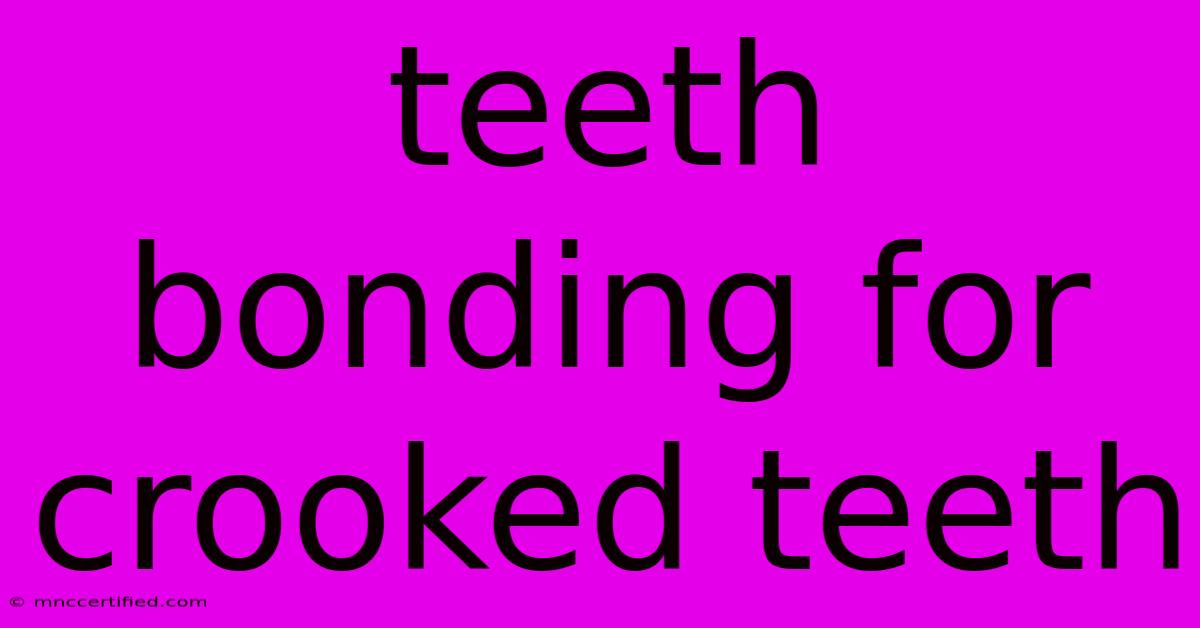Teeth Bonding For Crooked Teeth

Table of Contents
Teeth Bonding for Crooked Teeth: A Quick, Affordable Solution?
Are you unhappy with the appearance of your slightly crooked teeth? Do you dream of a straighter smile but shy away from the cost and commitment of traditional orthodontics like braces or Invisalign? Then you might want to explore teeth bonding as a potential solution. This cosmetic procedure offers a quick and often more affordable way to improve the look of minor imperfections, including slightly crooked teeth. However, it's crucial to understand its limitations and whether it's the right choice for you.
What is Teeth Bonding?
Teeth bonding is a cosmetic dental procedure where a tooth-colored resin material is applied to the surface of your teeth and then hardened with a special light. This resin can be sculpted and shaped to correct minor imperfections, making teeth appear straighter, longer, or whiter. For crooked teeth, bonding can effectively camouflage minor misalignments, creating the illusion of a straighter smile.
How Does it Work for Crooked Teeth?
The process involves several steps:
- Cleaning: Your teeth are thoroughly cleaned to ensure proper adhesion of the bonding material.
- Etching: A conditioning liquid is applied to slightly roughen the tooth's surface, improving the bond.
- Resin Application: The dentist applies a tooth-colored resin in thin layers, carefully shaping it to correct the crookedness.
- Hardening: A special light is used to harden and set the resin.
- Polishing: The bonded area is polished to a smooth, natural finish.
The entire procedure typically takes one or two appointments, depending on the extent of the correction needed.
Is Teeth Bonding Right for Your Crooked Teeth?
While teeth bonding offers a quick fix, it's not a suitable solution for everyone with crooked teeth. It's most effective for minor imperfections, such as:
- Slightly rotated teeth: Teeth that are turned slightly out of alignment.
- Minor gaps between teeth: Small spaces between teeth.
- Chipped or worn teeth: Bonding can also repair minor chips and wear.
Teeth bonding is NOT suitable for:
- Severely crooked teeth: Significant misalignment requires more extensive orthodontic treatment.
- Overbite or underbite: These bite problems necessitate orthodontic correction.
- Significant gaps: Large gaps between teeth are better addressed with other treatments.
Advantages of Teeth Bonding for Crooked Teeth
- Speed and convenience: Treatment is typically completed in one or two appointments.
- Affordability: Generally less expensive than braces or Invisalign.
- Minimal invasiveness: No removal of tooth structure is required.
- Improved aesthetics: Provides a noticeable improvement in the appearance of your smile.
Disadvantages of Teeth Bonding for Crooked Teeth
- Not a permanent solution: Bonding can chip or stain over time and may require replacement.
- Sensitivity: Some patients experience temporary tooth sensitivity after the procedure.
- Limited correction: Only suitable for minor imperfections.
- Staining: The bonding material can be more prone to staining than natural tooth enamel.
Teeth Bonding vs. Other Orthodontic Treatments
Let's compare teeth bonding with other common methods for straightening teeth:
| Feature | Teeth Bonding | Braces | Invisalign |
|---|---|---|---|
| Cost | Lower | Moderate to High | Moderate to High |
| Time | Short (1-2 appointments) | Long (months to years) | Moderate (months) |
| Invasiveness | Minimal | Moderate (brackets & wires) | Minimal (aligners) |
| Suitability | Minor imperfections | Significant misalignment | Significant misalignment |
| Permanence | Not permanent | Permanent (if retainers used) | Permanent (if retainers used) |
Finding a Qualified Dentist
Choosing the right dentist is crucial for successful teeth bonding. Look for a dentist with experience in cosmetic dentistry and a strong reputation. Schedule a consultation to discuss your concerns and determine if teeth bonding is the right option for you. Don't hesitate to ask questions about the procedure, potential risks, and expected outcomes.
Conclusion
Teeth bonding can be an effective and affordable way to improve the appearance of slightly crooked teeth. However, it's important to understand its limitations and whether it's appropriate for your specific needs. A consultation with a qualified dentist is essential to determine the best course of action for achieving your desired smile. Remember to research dentists thoroughly, reading online reviews and checking their credentials before making an appointment. A healthy and beautiful smile starts with informed decisions and a trusted dental professional.

Thank you for visiting our website wich cover about Teeth Bonding For Crooked Teeth. We hope the information provided has been useful to you. Feel free to contact us if you have any questions or need further assistance. See you next time and dont miss to bookmark.
Featured Posts
-
Motorcycle Insurance In Delaware
Nov 22, 2024
-
Maura Higgins Shane Mc Guigan Relationship Explained
Nov 22, 2024
-
Icc Warrants Netanyahu Gallant Hamas
Nov 22, 2024
-
Best Nfl Cards To Invest In 2023
Nov 22, 2024
-
Gaetz Replaced Bondi Is Trumps Pick
Nov 22, 2024